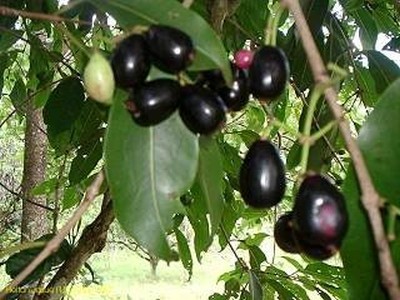
Common Name: Jamun
English Name: Jambul Tree
Botanical Name: Eugenia jambolana Lam; Syzigium cumini Skeels
Family: Myrtaceae
Description: Native to India, Pakistan and Indonesia found throughout Asia, Australia and is common in former British tropical colonies.A tree from 20 to 30 feet high, with long narrow peach-like leaves; flowers a greeny-yellow colour, in terminal bunches, blooming in July; the fruit varying from 12-36 mm long, red and rose colour.
Chemical Constituents: It contains anthocyanins, glucoside, ellagic acid, isoquercetin, kaemferol and myrecetin. The seeds are claimed to contain alkaloid, jambosine, and glycoside jambolin or antimellin, which halts the diastatic conversion of starch into sugar and seed extract has lowered blood pressure by 34.6% and this action is attributed to the ellagic acid content. The seeds have been reported to be rich in flavonoids, a well-known antioxidant, which accounts for the scavenging of free radicals and protective effect on antioxidant enzymes.
Properties: Jamun seeds are mainly used to treat diabetics. Traditionally jamun fruits and seeds are used to treat diabetes, pharyngitis and ringworm infection. Oral administration of dried alcoholic extracts of the seeds to diabetic patients was found to reduce the level of blood sugar and glycosuria in clinical trials. A decoction of the bark and powdered seeds is believed to be very useful in the treatment of diarrhea, dysentery and dyspepsia. Bark of this plant can also be used to treat excessive thirst, urinary disorders, hemorrhages and vaginal discharge. Eugenia jambolana seed apart from hypoglycemic activity has been reported to have anti-inflammatory, anttivity.
Used in the following MATXIN product: